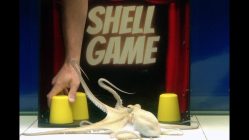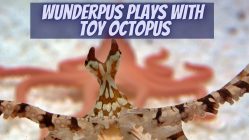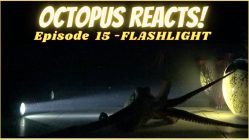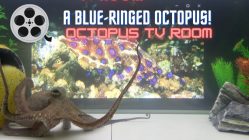
We bet that every child in the world would love to adopt a Flapjack Octopus as soon as they set their eyes on them. From all 300 octopus’ species, this is most probably the cutest one you’ve ever seen. That’ s why the Flapjack Octopus has inspired so many toy makers and you can nowadays find children items in the market featuring this little orange fellow, ranging from soft toys to plush hats. The most notorious Flapjack Octopus is the fictional character of Pearl, an octopus in the ‘Finding Nemo’ movie.
The species was first discovered by the American marine zoologist and malacologist S. Stillman Berry. They are one of the seven members of the genus Opisthoteuthis, otherwise known as ‘flapjack devilfishes’. Flapjack Octopus expert researchers have even considered the name Opisthoteuthis adorabilis in order to describe them. But the name Flapjack Octopus has been established to refer to their ability to flatten themselves out very thin, resembling a pancake or flapjack.
Generally speaking, this octopus species has been rarely observed and remains still understudied. There is no estimation as to how many Flapjack Octopus exist.
Flapjack Octopus Facts
- Scientific Name : Opisthoteuthis californiana
- Common Name: Flapjack Octopus
- Size: 20 cm (7.9 in) mantle length
- Weight: 25 – 30 grams
- Lifespan: 1.4 years and 2.6 years
- Found in: Eastern Pacific Ocean
- Sub-Order: Cirrina
- Discovered: 1949
- Scientific Name : Opisthoteuthis californiana
- Common Name: Flapjack Octopus
- Size: 20 cm (7.9 in) mantle length
- Weight: 25 – 30 grams
- Lifespan: 1.4 years and 2.6 years
- Found in: Eastern Pacific Ocean
- Sub-Order: Cirrina
- Discovered: 1949
Their best hunting trick is also the reason why this species is known as the Flapjack Octopus: by compressing and appearing more flattened, they seem to be less of a threat to their potential prey.
—Physical Appearance—

The Flapjack Octopus is a species of umbrella octopus. The term umbrella octopus is used to describe the way these octopuses swim, which looks as if they were a red umbrella parachuting down the ocean. The Dumbo Octopus also belongs in the same category. Similarly to the Dumbo, the Flapjack Octopus arms are also jointed and affixed together.
Their size is relatively small, their mantle length can be up to 20 centimeters. They are ovoid-formed, spongy, and gelatinous, with a transparent bright red, orange-red or pinkish coloration.
The Flapjack Octopus is also distinguished from other species from the existence of fins which are similar to ears and are attached to its mantles. The fins are one of the mechanisms it uses to successfully maneuver though the waters. In addition, this species lacks an ink sack, such a typical characteristic among other octopus species.
The Flapjack Octopus has bigger, more prominent, kidney-shaped and bovine-like eyes than other species. Their staring face, therefore, can be quite intimidating for their enemies who tend to be surprised and frightened if they happen to swim by one.
The Flapjack Octopus is the most compressed species in the anterior-posterior axis. It would definitely pass the squeeze challenge with flying colors!
Unlike other species, this octopus has only a single row of suckers on each arm similarly to all finned species. On the other hand, males are somewhat larger than their female as it is the case for many octopus species.
—A Pacific Resident—

Most of the specimens have been collected off the coasts of Japan and California. However, their distribution has been reported to extend from the Bering Sea to the Sea of Okhotsk and off central Honshū in the northwestern Pacific and off southern California in the northeastern Pacific.
But don’t rush to the Pacific to get yours just yet…
The Flapjack Octopus live into the very deep of the ocean, where there is not a lot of light. The newly hatched can be found at around 200 meters depth, while the depth range of the adults is from 500 to 1500 metres.
It is a benthic species but can be seen swimming as well. Nevertheless, they prefer to stay closer to the ground where they have access to food sources.
—What Do They Eat?—

Like other octopus species, the Flapjack Octopus feeds on small fish, planktons and other crustaceans (mysids, copepods, and crangonid shrimps) as well as polychaete worms.
They might look cute and innocent, but these adorable octopuses are quite capable of hunting and killing their prey. They do so by pouncing on their pray and killing it using their beaks. Their best hunting trick is also the reason why this species is known as the Flapjack Octopus: by compressing and appearing more flattened, they seem to be less of a threat to their potential prey.
When they are threatened to become food themselves, they quickly hide inside crevices or under rocks thanks to their small size.
—The Reproduction Process—

The female Flapjack Octopus produces around 225 to 475 eggs. The males try to attract females by performing various kinds of sexual rituals. The embryos are hatched out into a planktonic stage. The hatchlings stay with their mother for a very short time before they grow old enough to move to the benthic stage and survive independently.
—How Does the Flapjack Octopus Move?—
The uniqueness of the Flapjack Octopus also has to do with the way they move. When they swim, these swift octopuses use their fins as well as the web connecting their arms. Their fins are also used as navigators and render their movement gentler and smoother. At times, their funnels generate a propelling force that pushes them through the water. The Flapjack Octopus sometimes combines all these moving mechanisms and the result is simply captivating to watch. Their swimming seems like bouncing, parachuting, and dancing at the same time.











